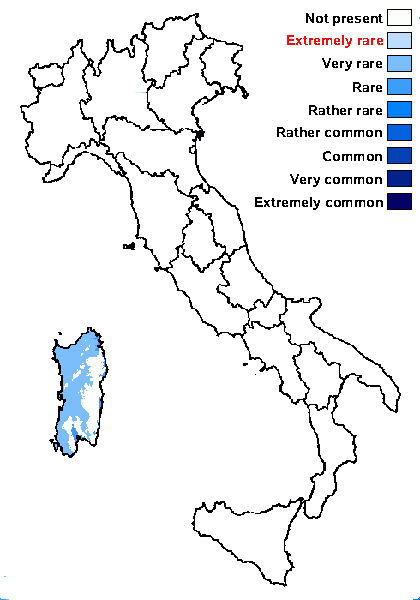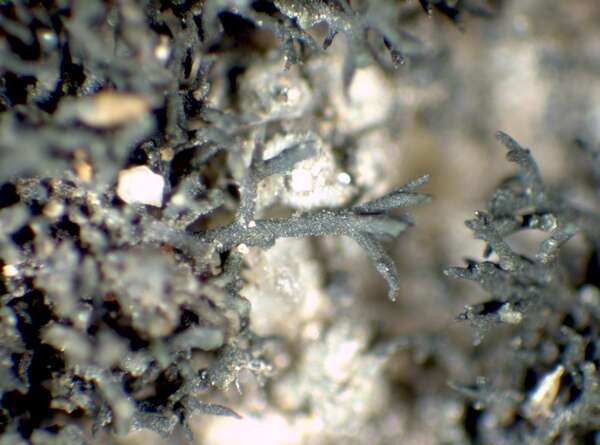Lichinella robusta Henssen
Symb. Bot. Upsal., 18, 1: 73, 1963.
Synonyms:
Distribution: C - Sar (Schultz 2000, Rizzi & al. 2011).
Description: Thallus microfruticose, black, of cylindrical, usually pointed, dichotomously branched, 2-3(-5) mm long, 0.07-0.15(-0.2) mm thick branches attached by bundles of rhizohyphae, forming regular to irregular, up to 20 mm wide cushions which are dispersed to contiguous, but not giving the impression of a rimose-areolate crust. Central part of branches with a distinct, fountain-like, dense hyphal strand consisting 4-5 µm thick hyphae with cylindrical cells, the peripheral parts made up of hyphae with more or less isodiametrical cells, encircling the photobiont cells. Apothecia thallinocarps, hemiangiocarpous, the ascogonia arising freely beneath the thallus surface, terminal on tips of branches, 0.2-0.35 mm across, with a flat to convex or rarely concave, rough disc, and a thin to thick thalline margin. Thalline exciple c. 70 µm wide; proper exciple absent; epithecium discontinuous, 15-20 µm high, with clusters of cyanobacterial cells penetrating in a wedge-like form into the hymenium; hymenium colourless, 70-100 µm high, K/I+ blue, the upper part with groups of photobiont cells intruding between the asci, covered by a more or less continuous layer of sterile thalline tissue; paraphyses stout, 3-4 µm thick, capitate; subhymenium colourless, compact, up to 80(-100) µm high, K/I+ blue. Asci 24(-36)-spored, subcylindrical to obclavate, prototunicate, with a thin, one-layered, non-amyloid wall, an amyloid external apical cap, and passive spore discharge via apical rupturing, Lichina-type. Ascospores 1-celled, hyaline, globose or subglobose, 5-7 x 4-5 µm. Pycnidia rare, terminal. Conidia cylindrical, c. 4 x 1-1.5 µm. Photobiont cyanobacterial, chroococcoid, of a few cells measuring 5-10 x 6-9 µm, penetrated by haustoria and surrounded by a brownish gelatinous sheath. Spot tests: all negative. Chemistry: without lichen substances. Note: on steeply inclined surfaces of base-rich siliceous rocks with periodical water seepage after rain; sometimes confused with L. stipatula, but certainly very rare in Italy.
Growth form: Fruticose filamentous
Substrata: rocks
Photobiont: cyanobacteria, coccaceous (e.g. Gloeocapsa)
Reproductive strategy: mainly sexual
On otherwise dry surfaces with short periods of water seepage after rain
Commonnes-rarity: (info)
Alpine belt: absent
Subalpine belt: absent
Oromediterranean belt: absent
Montane belt: absent
Submediterranean belt: absent
Padanian area: absent
Humid submediterranean belt: very rare
Humid mediterranean belt: very rare
Dry mediterranean belt: rare

Predictive model
Herbarium samples
Growth form: Fruticose filamentous
Substrata: rocks
Photobiont: cyanobacteria, coccaceous (e.g. Gloeocapsa)
Reproductive strategy: mainly sexual
On otherwise dry surfaces with short periods of water seepage after rain
Commonnes-rarity: (info)
Alpine belt: absent
Subalpine belt: absent
Oromediterranean belt: absent
Montane belt: absent
Submediterranean belt: absent
Padanian area: absent
Humid submediterranean belt: very rare
Humid mediterranean belt: very rare
Dry mediterranean belt: rare

Predictive model
| Herbarium samples |
 INDEX FUNGORUM
INDEX FUNGORUM
 GBIF
GBIF



